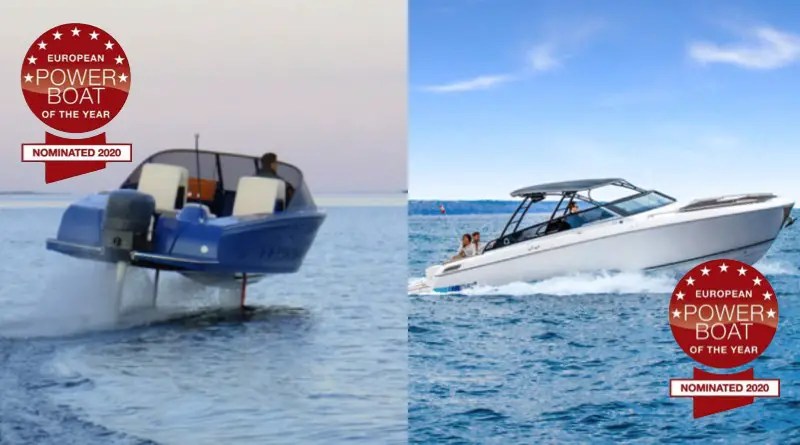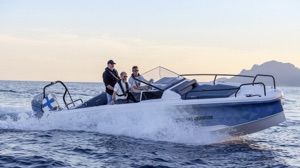Powerboat of the Year nominees included 2 electric boats
The European Powerboat of the Year nominees included 2 electric boats in 2020, a huge confirmation of the rapid advance in electric boat technology and capability. The two boats are the Candela 7 hydrofoiling speedboat which has been specifically designed for electric propulsion and the NEO HT from Greenline, which can be ordered electric powered or gasoline/petrol.
The awards were presented at Boot Duesseldorf January 18, and while neither came home with the top prize, this is quite a tribute to the companies, as there are only 5 nominations in each size category in the Awards. The Candela is in the under 25 foot class and the Greenline in the 35′ to 45′ foot class.
Powerboat of the Year nominees earned their place: electric or fossil fuel
There are hundreds of boats in each of those classes, so to be selected as among the top 5 is a great tribute for any boat. But for an electric boat, the achievement is even bigger. There is no quota of electric boats or stipulation that e-boats have to be included. These are among the top 5 powerboats in their class. Period. (Or ‘full stop’, as some say.) Congratulations!
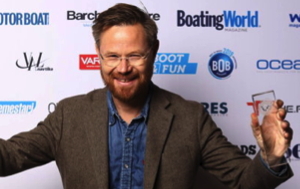
For Candela, this is the second time in a year they have been nominated in awards for what used to be exclusively combustion engine competitions. And in the Best of Boat Show in November they came out as the winner! In fact, electric boats took home 1/3 of the trophies, with Candela winning in ‘Best For Future’ and the Silent Yachts 55 solar powered catamaran winning in ‘Best For Travel’
Nominees took approaches to the electric powerboat future
Greenline Yachts is widely recognized as the pioneer of hybrid propulsion for recreational yachts and boats. It was more than 10 years ago, in 2009, that they first introduced a powerboat incorporating both electric and diesel propulsion. But the concept was literally decades in the making.
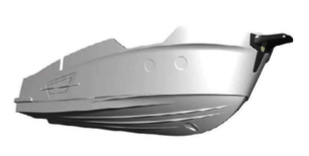 The key to making a hybrid viable was a different hull design – the ‘superdisplacement’ hull – that took some angles and shapes from sailing hulls and some aspects of powerboat hulls to create something that is ‘slippery’ in the water and gets the most range and performance out an electric motor.
The key to making a hybrid viable was a different hull design – the ‘superdisplacement’ hull – that took some angles and shapes from sailing hulls and some aspects of powerboat hulls to create something that is ‘slippery’ in the water and gets the most range and performance out an electric motor.
The hull was the creation of Slovenia’s Jakopin brothers, Japec and Jernej of JnJ Design who began sailing in their teens and spent decades designing for sail and powerboat companies like Jeanneau, Fairline and Sea Ray. Almost 60 thousand boats were constructed based on their designs, and those designs have won 33 Boat of the Year awards.
While their first hybrid, the Hybrid 33 was a real breakthrough for Greenline back in 2009, the financial environment at the time was not the best for yacht sales. The boats sold well with all things considered, but still struggled and in 2015 the company was sold to one of their major dealers, Vladimir Zinchenko.
 Mr. Zinchenko turned the company’s finances around, continued to work with JnJ Design, continued to expand the breadth of the Greenline fleet, and in 2019 came out with the NEO, its first boat available in electric or gasoline (rather then electric/diesel/hybrid). The 9.9 metre boat is available in an open design, or as a hardtop or coupe with 1.3 kW of solar panels.
Mr. Zinchenko turned the company’s finances around, continued to work with JnJ Design, continued to expand the breadth of the Greenline fleet, and in 2019 came out with the NEO, its first boat available in electric or gasoline (rather then electric/diesel/hybrid). The 9.9 metre boat is available in an open design, or as a hardtop or coupe with 1.3 kW of solar panels.
The electric model is powered by Twin Torqeedo 55.1 kW Torqeedo Deep Blue outboards and dual 30.5 kWh (totalling 61 kWh) BMW i3 batteries. In addition to being nominated for last week’s Powerboat of the Year honours, it also won the prestigious BIG design award in Ljubljana, Slovenia.
Candela’s hydrofoiling speedboat is a marvel of software and technology
If the success of Greenline is based on studying boat designs that go back decades or even centuries and merging them in a radical and innovative way, Candela’s approach is the opposite. Founder Gustav Hasselskog quite intentionally turned his back on traditional boatbuilders because his science and philosophy background told him the way to crack the challenge of creating an electric boat with both speed and range was to look at everything in an entirely new way.
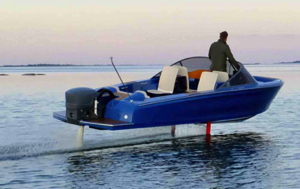 That entirely new way was hydrofoiling, because if a superdisplacement hull reduces drag – then hydrofoiling virtually eliminates it! The only problem is that hydrofoiling is comparatively easy for a surfboard, but an entirely different proposition for a 7.7 metre speedboat.
That entirely new way was hydrofoiling, because if a superdisplacement hull reduces drag – then hydrofoiling virtually eliminates it! The only problem is that hydrofoiling is comparatively easy for a surfboard, but an entirely different proposition for a 7.7 metre speedboat.
As it says on the Candela website: “We joined together some of the world’s brightest minds within their fields: hydrofoil technology, carbon composites, transmission design, power electronics, dynamic modeling, self-learning, control theory and a lot of software development. “
The Candela team includes an electrical engineer who has developed missile defence systems for fighter jets, a a systems engineer who has worked on drones and quadcopters, robotics experts…and when they started working with dynamics modelling specialists and a PhD in hydrodynamics, their hydrofoiling boat concept literally started to fly. About one metre above the water!
One of the keys to getting the best performance, of course, was to make the boat as light as possible, so the Candela is carbon fibre throughout (except for some very tasteful teak decks). That all weighs in at a mere 1300kg but the real technological marvel is a software and hardware system in which the foil positions are changed 100 times per second. All of which takes place when the boat is speeding along at up to 30 knots.
It was 2015 when the Candela crew first took on the task of creating an electric boat that could be a match for fossil fuel boats, and the result is a vessel that can cruise along at a recommended 17-23 kt clip for a range of up to 50 NM, depending on conditions.
So…two approaches to electric boats, two nominations recognizing that these are among the 5 best boats in their class no matter what they use as propulsion…but unfortunately neither took home the big prize. However, it’s a great step forward, and look out for the announcement of next year’s European Powerboat of the Year nominees – the electric boats are coming!

